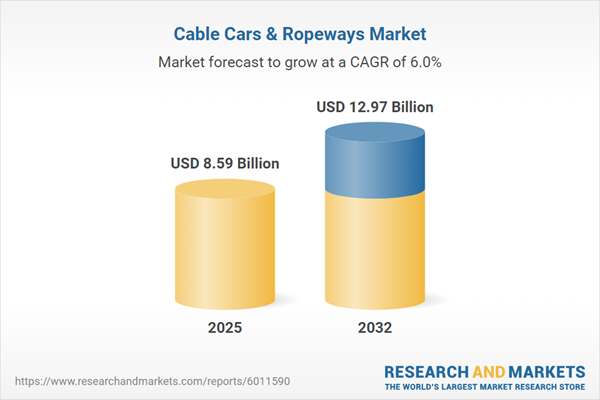Speak directly to the analyst to clarify any post sales queries you may have.
As urban populations grow and cities seek efficient ways to improve accessibility, the cable cars and ropeways market is gaining ground as a flexible transit solution for both established and developing areas. This technology enables seamless links between congested urban zones and underserved regions, making it a compelling option for forward-thinking decision-makers.
Cable Cars and Ropeways Market Snapshot
The global cable cars and ropeways market reached a value of USD 8.11 billion in 2024, with projected growth to USD 8.59 billion in 2025 and an anticipated rise to USD 12.97 billion by 2032. This trend demonstrates a compound annual growth rate (CAGR) of 6.04%. Ongoing investment from both public and private sectors underscores the focus on scalable transit infrastructure. Expanding demand for sustainable mobility, coupled with rising tourism and evolving passenger expectations, is accelerating adoption. Cable-based systems also provide adaptability, enabling diverse operators to address a wide range of regulatory and operational demands across global markets.
Scope & Segmentation of the Cable Cars and Ropeways Market
- Application: Solutions aim to reduce urban congestion, diversify commuter pathways, improve access to remote tourist destinations, and strengthen both daily and leisure connectivity.
- System Type: Product categories cover aerial tramways, chairlifts, gondola lifts, and funicular railways, each offering distinct benefits suited to various capacities and terrains.
- Technology Type: Market deployment includes monocable, bicable, and tricable configurations, supporting project customization for efficiency, maintenance, and scope.
- Operation Type: Installations may be publicly funded, privately operated, or implemented through public–private partnerships, allowing tailored governance to fit local objectives.
- Installation Type: Activity spans network development, modernization, and retrofitting, enabling both new projects and upgrades to meet changing transit standards.
- End User: Systems are deployed by government transport authorities for community access and by private tourism operators to elevate visitor experiences.
- Capacity Type: Options are designed for steady commuter use or adjusted to accommodate fluctuating demands during tourism peaks, optimizing performance and adaptability.
- Speed Category: Providers deliver high-speed mobility for urban integration and lower-speed, comfort-centric alternatives for scenic travel requirements.
- Region: Adoption occurs in the Americas, Europe, Middle East and Africa, and Asia-Pacific, with variation based on policy context and financing.
- Countries Covered: Both mature markets like the United States and Germany and emerging economies such as China, India, Australia, and Brazil are addressed, with coverage extending across APAC, EMEA, and the Americas.
- Notable Companies: Key players include Doppelmayr Seilbahnen GmbH, Leitner AG, POMA SAS, Bartholet Ropeways AG, CWA Constructions SA, Sigma Cabins SpA, BMF S.p.A., Tatralift a.s., Agudio S.p.A., and Yasutake Co., Ltd.
Key Takeaways for Senior Decision-Makers
- Cable-based transit integrates seamlessly with existing urban networks, improving accessibility and smoothing travel for residents and tourists.
- Local partnerships and resilient supply chains help businesses adapt procurement strategies to shifting trade environments and localization mandates.
- Digital analytics and predictive maintenance platforms enhance transparency and reliability across operations, enabling timely responses to emerging issues.
- Modular system architectures support rapid rollout and simplify integration with legacy infrastructure, accommodating phased upgrades.
- Flexible project funding and contracting options provide stakeholders with agility to align with evolving regulations and operational needs.
Tariff Impact on Procurement and Localization
Recent changes to United States tariffs have led companies to broaden sourcing strategies and reinforce local supplier networks. These actions improve operational resilience, reduce supply interruptions, and help organizations meet evolving project timelines amid trade and economic fluctuations.
Research Methodology & Data Sources
This report draws on a triangulated methodology, combining executive interviews, technical benchmarking, and supply chain analysis to deliver a robust view of the sector. Supplementary sources include regulatory reviews, real-world case studies, and procurement audits, ensuring actionable data for strategy development.
Why This Report Matters for the Cable Cars and Ropeways Market
- Enables procurement and operations leaders to manage supplier exposure, support compliance, and maintain regional competitiveness.
- Delivers focused analysis on improving system uptime through digital tools and modular deployment, relevant to both new installations and upgrades.
- Prepares organizations to adapt to ongoing regulatory changes by leveraging scalable transit technologies that maximize infrastructure longevity.
Conclusion
Cable cars and ropeways are reshaping transit access and tourism mobility on a global scale. This report offers comprehensive market analysis to support well-informed strategic decisions in this evolving environment.
Additional Product Information:
- Purchase of this report includes 1 year online access with quarterly updates.
- This report can be updated on request. Please contact our Customer Experience team using the Ask a Question widget on our website.
Table of Contents
3. Executive Summary
4. Market Overview
7. Cumulative Impact of Artificial Intelligence 2025
Companies Mentioned
The companies profiled in this Cable Cars & Ropeways market report include:- Doppelmayr Seilbahnen GmbH
- Leitner AG
- POMA SAS
- Bartholet Ropeways AG
- CWA Constructions SA
- Sigma Cabins SpA
- BMF S.p.A.
- Tatralift a.s.
- Agudio S.p.A.
- Yasutake Co., Ltd.
Table Information
| Report Attribute | Details |
|---|---|
| No. of Pages | 184 |
| Published | November 2025 |
| Forecast Period | 2025 - 2032 |
| Estimated Market Value ( USD | $ 8.59 Billion |
| Forecasted Market Value ( USD | $ 12.97 Billion |
| Compound Annual Growth Rate | 6.0% |
| Regions Covered | Global |
| No. of Companies Mentioned | 11 |









